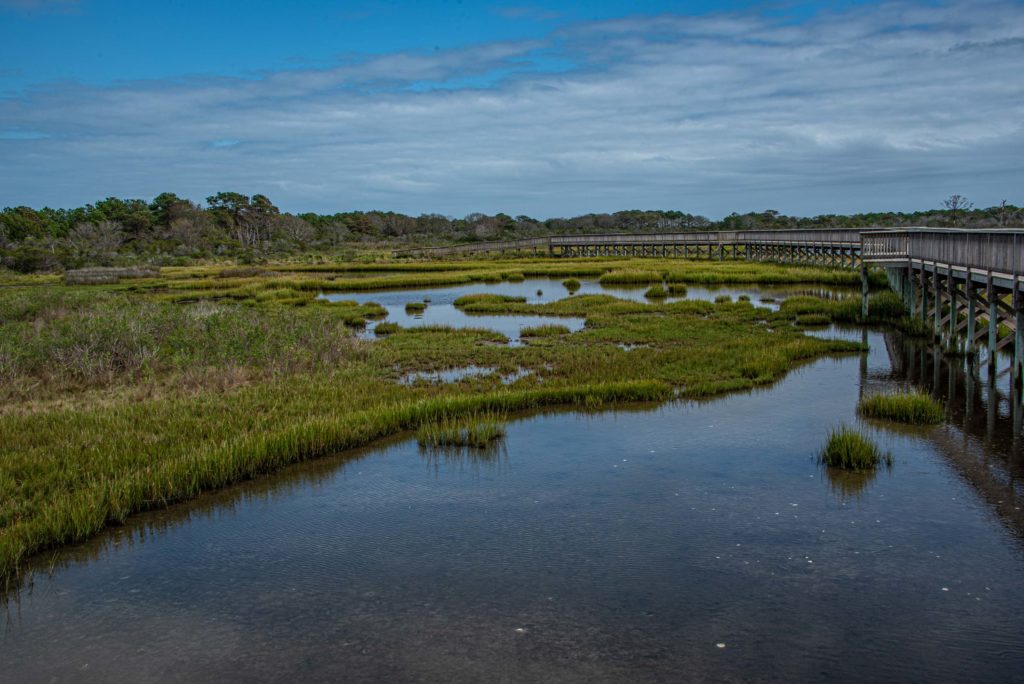It’s September, my birthday month. One of my favorite celebrations is enjoying a new experience with friends. This year it’s Assateague Island National Seashore.
Rick and I live part time in Lewes, Delaware. The “first town in the first state” perches on the east coast about halfway down the Delmarva Peninsula. The “Delmarva” combines the little bits of Delaware, Maryland, and Virginia that comprise this 170-mile-long land mass. The Peninsula hosts rich farmlands, beautiful beaches, and old towns and fishing villages, some dating back to the seventeenth century. With Delaware Bay and the Atlantic Ocean on the east and Chesapeake Bay on the west, we’re close to a soul-nourishing body of water. Delmarva life slows down— residents and visitors call it “Lower Slower Delaware”—and the farther south you travel, a southern lifestyle begins to influence Delmarva’s pace. I see it in the architecture, hear it in accents, feel it in the slower rhythm of life.
Getting to Assateague Island from Lewes, DE
We pile into our Hyundai for the one-hour drive from Lewes to Assateague. Rick drives, with friends Dianna and Doug in the back, and me riding shotgun with my Nikon D750 camera. The 37-mile-long barrier island sits on Delmarva’s east coast facing the ocean straddling the Maryland and Virginia border. After eating outdoors COVID-style at the charming Atlantic Hotel in the historic early nineteenth century town of Berlin, Maryland, we turn east and cross the Verazzano Bridge over Sinepuxent Bay onto Assateague. Visitors can enter the island from either end, but you can’t drive from one end to the other; no road connects them. Straight ahead is the state park, but we turn right instead into the National Seashore Park. Pay $25 for single-day parking or have a pre-purchased annual national park pass, and you’re inside.
Wild horses couldn’t drag me away
Within a few hundred yards we run into a traffic jam on this narrow two-lane park road. Drivers stopped to watch and photograph a small herd of Assateague ponies grazing within five feet of my rolled-down window. They’re actually horses, slightly smaller in stature as a result of their poor source of nutrition over several centuries. There’s a romantic story of their arrival on the island. The horses were cargo on Spanish galleons that shipwrecked and sank off the coast; the animals then made their way to the island. A more believable storyline may be that seventeenth century farmers on the mainland brought horses to the island to avoid paying livestock taxes. The horses escaped from the farmers into the island’s sandy hummocks, tidal marshes, and red cedar woods.
The ponies appear docile. They are not. Despite stern warnings from the Park Service to stay in your car and not approach them on foot, every year curious, foolish people try to pet them and suffer bites and kicks from these beasts. The Park’s website displays photos of victims to prove it.
Still, the ponies are fun to watch. Only in old western movies and TV shows did I ever get a chance to watch packs of wild horses gallop across plains and through ravines.
Impatient drivers beep to goad stopped cars along, and we slowly move farther into the park.
I’ve always loved mid-Atlantic coastal landscapes: loblolly, white, and short-needled pines, Virginia cedars (junipers), sand dunes of wild beach grasses, salt marshes with cordgrass colonies, bayberry thickets, and wax myrtles. The constant winds raking the sandy coasts naturally prune trees and shrubs. These landscapes often move with the breeze and the low local profile also reveals an enormous sky. I feel nakedly alive and my spirit soars in these open spaces, knowing the all-powerful ocean paws the shoreline nearby. Assateague Island is a satisfying study as we cruise the park roads, taking in the scenery.
Following the Park Service map, we turn right towards the bayside’s marsh trail, one of three designed to introduce visitors to the island’s wonders. Parking, we enter the trail. It leads us through underbrush, then transforms into a boardwalk rising ten feet above the marsh for the remainder of the trail. The boardwalk provides us with a low flying bird’s eye view of shallow pools reflecting the clouds, interrupted by a mosaic of cordgrass. The bay fills the horizon.
Finding “true blue”
Spying a Great Blue Heron always thrills me. It stands in shallow water with its body perched on pencil-thin legs topped with a long, S-shaped neck, its pointed beak ever-ready to snap forward into the water to snag a small fish, insect, or crab. Its sleek in-flight outline reminds me of the SST jets of a few decades ago. Yet, despite its name, its color is a slaty gray blue. I always wish it were bluer.
But what’s this, 10 feet below me?! A very blue heron hunting in the shallows for a tasty snack. A fellow photographer setting up his tripod tells me it’s a Little Blue Heron, a species distinct from its greater cousin. The bird’s smokey blue feathers make the animal pop out from the afternoon sun’s chartreuse foliage of salt marsh cordgrass.
A few steps down to a small bay beach a family picnics. Two kids explore the shoreline and splash in the shallows. No one else is around. I breathe in an idyllic peacefulness and the smell of tidal waters, always a little funky. Across the calm bay sparkling in the afternoon sun, houses dot the Maryland shoreline. For a moment everything’s okay in the world.
We all want to see the ocean. We park in the South Lot, cross a broad dune into a stiff breeze, and at its crest the Atlantic Ocean produces its crash of stark white waves, glinting in the sunlight. Bathers are sprinkled across the beach; parents keep their eyes on children playing at the rough surf’s edge. Shoes off, I walk into the last wave to feel the warmth of late summer, unaware of what’s coming next: a curling wave of the incoming tide crashes in front of me and my shorts take its full force.
My shorts almost dry by the time we get home. This birthday excursion was the perfect celebration for the soul. Assateague Island National Seashore offers visitors a chance to experience the starkly beautiful coastal Mid-Atlantic landscape and see some of nature’s inhabitants.
If You Go
- From New York and Philadelphia: Take U.S. 95 South to Delaware State Rt.1 South. At Milford, take U.S. 113 South to Berlin, Md, then Rt. 376 East to Rt. 116. Turn right, proceed to Assateague Island
- From Washington and Baltimore: Take U.S. 50 East across Chesapeake Bay Bridge. Stay on 50 to U.S. 113 South into Berlin, Md. Take Rt. 376 East to Rt. 116. Turn right, proceed to Assateague Island
- From Norfolk and Virginia Beach: Take U.S. 13 North across Chesapeake Bay Bridge-Tunnel; proceed to U.S. 113 North near Pocomoke City. Take U.S. 113 to Berlin, Md. Take Rt. 376 East to Rt. 116, turn right and proceed to Assateague Island.
- RECOMMENDED: If you have the time, visit the Virginia portion of Assateague Island about 47 miles south from Berlin. Take U.S. 113 South to Rt. 12 South out of the small town of Snow Hill. Turn east at Rt. 175 to the town of Chincoteague. This town’s charm warrants an overnight visit in one of several bed and breakfast inns, dining in its many restaurants, and browsing in Main Steet’s arts and craft shops. From there it’s only a few miles to the Island, with lots of trails, seashore, and…yes, ponies.


